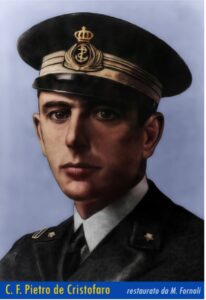Context
In the first three months of 1941, the transfer of Axis supplies and men to Libya went practically unopposed (94% and 95% arrived), with scattered British air and submarine attacks. This flow of men and equipment allowed Rommel to launch his bold advance into Cyrenaica, recapturing Bengasi already on the 4th of April. The situation led Admiral Cunningham to request more naval and aerial assets for the Mediterranean theatre to bolster the anti-shipping campaign. In the meantime, he detached the 14th Destroyer flotilla (HMS Jervis, HMS Janus, HMS Nubian and HMS Mohawk) to Malta, hoping to increase the sea interdiction to axis shipping. These ships arrived on the 11th of April, the same day Tobruk became surrounded.
The Tarigo convoy
On 13 April 1941, a consistent convoy left Naples, with destination Tripoli. The merchant ships Sabaudia, Aegina, Iserlohn, Arta, and Adanam, carried men and ammunition. They were escorted by the destroyers Luca Tarigo (leading the convoy), Baleno and Lampo. Between 14 and 15 April, a storm dispersed the convoy. Once it regrouped, British reconnaissance aircraft sighted the ships and the 14th flotilla (led by Captain P.J. Mack) left Malta on the evening of the 15th of April. Around 1.30-1.45 AM on 16 April 1941, the convoy approached the shoals of Kerkennah off the Tunisian coast. At 1.40 a blip appeared on the radar of HMS Nubian. The Italians were 11km away and the British moved to intercept them. Mack decided to attack the convoy from behind, having plenty of time to manoeuvre since the convoy was proceeding at slow speed.

At 2.20 AM, Mack ordered to open fire when his ships were just 2km behind the Italians. The destroyers Lampo and Baleno were hit first and reduced to floating wrecks. They subsequently run aground on the shoals of Kerkenah. Surprisingly the Lampo was even salvaged a couple of months later. The British destroyers then concentrated on the five merchant ships, hit in succession in the space of a few minutes. The Luca Tarigo, at the head of the convoy, saw hell raging on behind it and Captain Pietro De Cristofaro immediately ordered the reverse course to launch a counterattack.
During the manoeuvre, the Luca Tarigo received a hit under the bridge, destroying the rudder and transmission apparatus. Captain De Cristofaro was hit by splinters and lost a leg, while several other men were killed or severely injured. The ship eventually returned fire against HMS Nubian, at a few hundred meters distance, causing light damage.
The situation on the Tarigo was dire, some surviving officers activated the aft rudder and transmission commands, bringing the ship closer to the enemy. Fires continued to rage while the main armament was out of action, and the crew was decimated.
Chief engineer, Captain Luca Balsofiore, died next to Captain De Cristofaro after reporting the engine apparatus was no longer operational.
A group of survivors, led by vessel lieutenant Ettore Bisagno, reached the only operating torpedo tubes still functioning. The torpedo sub-director Adriano Marchetti aimed and launched three torpedoes.
Two of them reached the destroyer HMS Mohawk, fatally crippling the ship. The Luca Tarigo subsequently sank, leaving 36 survivors out of 230 men. HMS Mohawk was scuttled and soon after, Mack’s surviving destroyers left the area. The next day, the Regia Marina launched a rescue operation to recover the survivors, including Lt. Bisagno, who will later join the 4th M.A.S. flotilla in the Black Sea where he will eventually die on a M.A.S. boat.
Two Gold Medal for Military Valour (MOVM) were issued, posthumously, by the Regia Marina: one to Captain De Cristofaro and one to Luca Balsofiore. Ettore Bisagno received the Silver Medal for Military Valour (MAVM).
With the destruction of the Tarigo convoy, 1.700 men, 300 vehicles and 3.500 tons of supplies went lost. Undoubtedly, this was a heavy blow for the Regia Marina and the Axis army in Libya. However, the overall supply flow will not be severely affected until July-August 1941. The loss of the Tarigo convoy subsequently led the Regia Marina to launch a seaborne assault against Malta, utilizing the X° M.A.S. flotilla.



A special thank goes to Matteo Fornoli and his passion. He retrieved the pictures of these men, carrying out an outstanding job of restoration and colorization.
Sources
Brescia, M. (2018). Cacciatorpediniere classe “Navigatori”.
Giorgernini, G. (2001). La Guerra Italiana sul mare, La marina tra vittoria e sconfitta 1940-1943.
Hammond, R. (2020). Strangling the Axis: The Fight for Control of the Mediterranean during the Second World War.
O’Hara, V. P. (2008). Struggle for the Middle Sea: The Great Navies at War in the Mediterranean Theater, 1940-1945.